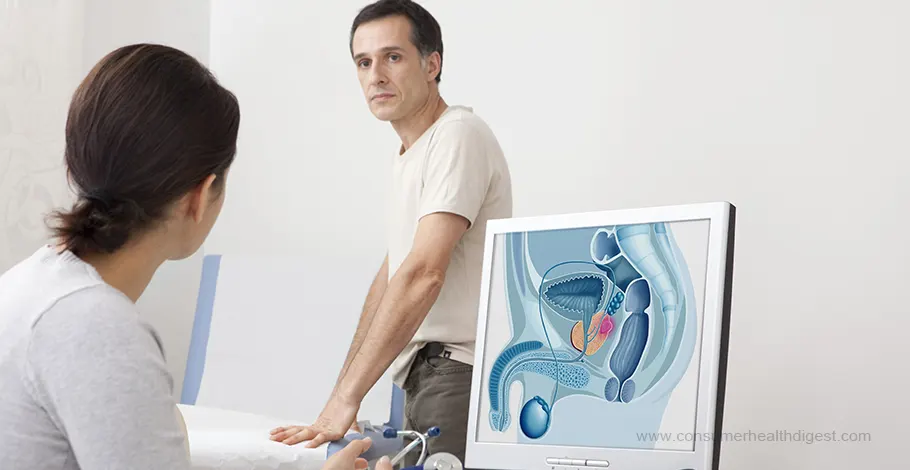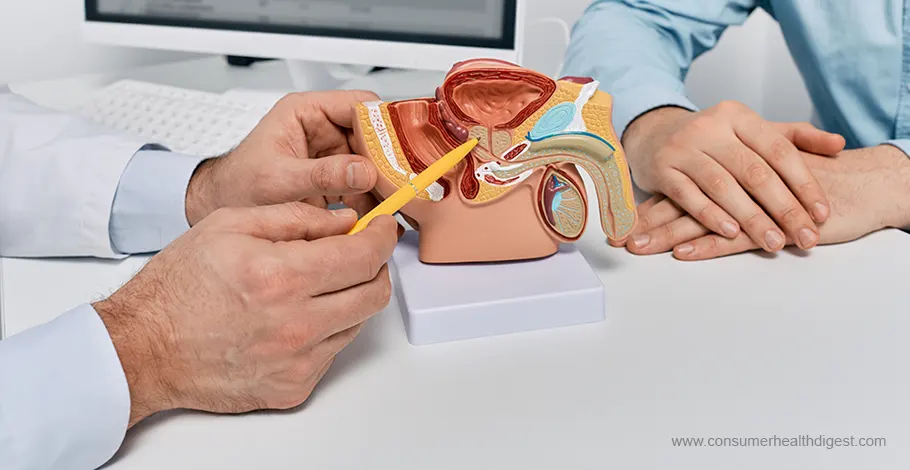Introduction
One prevalent type of cancer that affects men and people who are born with a male gender identity is prostate cancer. The prostate gland, a little organ the size of a walnut that is situated in front of the rectum and beneath the bladder, is where it develops. Even though it can be a dangerous condition, the likelihood of recovery and survival can be greatly increased with early discovery and appropriate treatment. [1]

For prostate cancer to be properly managed, early detection and prompt treatment are essential. People can improve their chances of receiving effective treatment and recovering from the condition by being aware of it, identifying the signs, and getting screened frequently. Since prostate cancer is frequently curable, particularly if detected early, health awareness and proactive care are crucial. [2]
Understanding Prostate Cancer
Anatomy and function of the prostate gland
With its ability to produce fluid that both nurtures and shields sperm, the prostate gland is an essential component of the male reproductive system. Men tend to have larger glands, and over time, there is a higher chance that cancer may form in these cells. It's critical to comprehend the structure and operation of the prostate to identify possible problems. [3]
Risk factors and predisposing conditions
Prostate cancer risk factors include age (risk increases dramatically beyond age 50), race (African American males are more likely to acquire prostate cancer), family history, and lifestyle choices like exercise and nutrition. Prostate cancer risk may also be raised by a few diseases, including proliferative inflammatory atrophy (PIA) and prostatic intraepithelial neoplasia (PIN). [4]
Common symptoms and signs
Regular screenings are essential since prostate cancer frequently shows no signs in its early stages. Common symptoms of the condition include trouble urinating (poor or interrupted flow), increased frequency or urgency, blood in the urine or semen, and hip, lower back, or pelvic pain. But these symptoms might also point to other non-cancerous illnesses, which emphasizes the significance of a thorough medical assessment. [5]
Diagnosis and Screening

Diagnosis and Screening of Prostate Cancer. Shutterstock Image
Screening methods: PSA test, digital rectal exam
Prostate cancer must be identified early through routine screenings. The digital rectal examination (DRE) and the prostate-specific antigen (PSA) blood test are two frequently used screening techniques to find anomalies in the prostate gland. While aberrant DRE findings or elevated PSA levels do not always point to malignancy, they might certainly warrant more testing. [6]
Diagnostic procedures: biopsy, imaging tests
To establish the existence and degree of cancer, additional diagnostic procedures like biopsies and imaging tests (such as MRIs or ultrasounds) may be advised if screening results raise any red flags. For a conclusive diagnosis, a biopsy is frequently required, in which a tiny sample of prostate tissue is taken and examined under a microscope. [7]
Importance of regular screenings
Frequent screenings can significantly increase the likelihood of detecting prostate cancer early, when it is most curable and controllable, especially for men over 50 or those with risk factors. It is crucial to talk about screening recommendations with a medical professional in light of each patient's unique risk factors and general health.
Treatment Options
Active surveillance
For slow-growing, low-risk instances, active surveillance—which entails regularly monitoring the cancer by routine PSA tests, biopsies, and other examinations—may be advised. With this strategy, treatment can be postponed until the malignancy manifests symptoms, allowing for action.
Surgery: prostatectomy
To eradicate the cancer, surgery, such as a radical prostatectomy, attempts to remove the prostate gland entirely as well as any surrounding tissues. Open surgery or less invasive methods, such as robotic-assisted laparoscopic surgery, can be used to accomplish this operation. [8]
Radiation therapy
High-energy beams or radioactive seeds inserted into the body are used in radiation therapy to kill cancer cells with the least amount of harm to healthy organs. Common radiation treatments for prostate cancer include brachytherapy (internal radiation) and external beam radiation therapy (EBRT). [9]
Hormone therapy
The goal of hormone treatment is to specifically target and inhibit the activity of testosterone, a hormone known to promote the growth of cancer. Depending on the cancer's stage and characteristics, this treatment may be utilized as a stand-alone alternative or in conjunction with other therapies. [10]
Chemotherapy
Strong medications are used in chemotherapy to quickly split cancer cells all across the body. When prostate cancer is progressed or metastatic that is, when the cancer has spread outside of the prostate gland it is frequently used. [11]
Emerging therapies and clinical trials
New hope for effective treatment options with fewer side effects is being offered by emerging therapies like immunotherapy, which uses the body's immune system to fight cancer, targeted therapy, which targets specific molecular targets in cancer cells, and focal therapy, which only destroys the cancerous portion of the prostate. These therapies are constantly being researched and developed.
Living with Prostate Cancer
Coping strategies and support systems
It might be difficult to deal with a prostate cancer diagnosis on an emotional and physical level. During this challenging journey, having a strong support network, getting therapy, and attending prostate cancer support groups can all help provide much-needed emotional support, useful advice, and a sense of community. [12]
Lifestyle changes and dietary considerations
Maintaining a balanced diet full of fruits, vegetables, and whole grains, exercising frequently, abstaining from tobacco use, and limiting alcohol intake are all components of a healthy lifestyle that can enhance general well-being and potentially mitigate the side effects of prostate cancer treatment. [13]
Managing treatment side effects
Urinary incontinence, erectile dysfunction, and infertility are among the side effects that might result from some treatment options, like radiation therapy or surgery. These worries can be reduced and quality of life enhanced by open discussion with healthcare practitioners and proper treatment options, such as pelvic floor exercises, medication, or fertility preservation techniques. [14]
Importance of regular follow-ups and monitoring
To assess the disease's course and the efficacy of treatment, routine monitoring and follow-ups are crucial for making any necessary adjustments or interventions promptly. Depending on the specific situation, routine PSA testing, imaging scans, or biopsies may be required.
Future Directions
Advances in research and treatment
Our understanding of prostate cancer is constantly growing as a result of ongoing research and clinical studies, which are also leading to the development of more potent treatments with fewer side effects. Potential paths to better patient outcomes include developments in personalized medicine, targeted medicines, and genomics.
Promising technologies and therapies on the horizon
There is hope for more individualized and precise treatment options in the future thanks to promising technologies like targeted therapies that precisely attack cancer cells while sparing healthy cells and advanced imaging techniques like multiparametric MRI, which can provide detailed images of the prostate and surrounding tissues.
Importance of awareness and advocacy
All those impacted by prostate cancer can benefit from improved access to high-quality care, early detection, and support for research projects through raising awareness and advocating for policy changes. Prostate cancer can be effectively fought by raising money, taking part in awareness campaigns, and supporting organizations that support patient assistance and research.
Conclusion
Although prostate cancer is a serious health risk, those who are affected can significantly improve their quality of life and prognosis with early identification and adequate treatment. Prostate cancer is treatable in many cases, even curable, with proper education, frequent screenings, and fast medical intervention.
Prostate cancer survivors can improve their chances of beating the disease or living well with it by being informed, getting frequent checkups, and actively managing the condition in collaboration with medical specialists.
By raising awareness, funding research, and enabling ourselves and our loved ones to take proactive measures toward early identification and efficient treatment of this illness, let's all do our part to combat prostate cancer. By working together, we can defeat prostate cancer and enhance the quality of life for all who are impacted by it.
14 Sources
We review published medical research in respected scientific journals to arrive at our conclusions about a product or health topic. This ensures the highest standard of scientific accuracy.
[1] Cunha GR, Vezina CM, Isaacson D, Ricke WA, Timms BG, Cao M, Franco O, Baskin LS. Development of the human prostate. Differentiation. 2018 Sep-Oct;103:24-45. doi: 10.1016/j.diff.2018.08.005. Epub 2018 Sep 4. PMID: 30224091; PMCID: PMC6234090.[2] Leslie, Stephen W., et al. "StatPearls [Internet]." Prostate Cancer. StatPearls Publishing, 13 Nov. 2023, www.ncbi.nlm.nih.gov/books/NBK470550.
[3] "InformedHealth.org [Internet]." How does the prostate work? Institute for Quality and Efficiency in Health Care (IQWiG), 23 Aug. 2016, www.ncbi.nlm.nih.gov/books/NBK279291.
[4] Gann PH. Risk factors for prostate cancer. Rev Urol. 2002;4 Suppl 5(Suppl 5):S3-S10. PMID: 16986064; PMCID: PMC1476014.
[5] "Prostate Cancer - Symptoms and Signs." Cancer, 10 Feb. 2023, www.cancer.net/cancer-types/prostate-cancer/symptoms-and-signs.
[6] "Prostate Cancer Screening." National Cancer Institute, 19 Apr. 2024, www.cancer.gov/types/prostate/patient/prostate-screening-pdq.
[7] website. "Diagnosis." Nhs, 14 Feb. 2024, www.nhs.uk/conditions/prostate-cancer/diagnosis.
[8] Pereira R, Joshi A, Roberts M, Yaxley J, Vela I. Open retropubic radical prostatectomy. Transl Androl Urol. 2020 Dec;9(6):3025-3035. doi: 10.21037/tau.2019.09.15. PMID: 33457276; PMCID: PMC7807367.
[9] "Radiation Therapy for Prostate Cancer." Prostate Cancer Foundation, 16 Sept. 2022, www.pcf.org/about-prostate-cancer/prostate-cancer-treatment/radiation-prostate-cancer.
[10] Namiki M, Ueno S, Kitagawa Y. Role of hormonal therapy for prostate cancer: perspective from Japanese experiences. Transl Androl Urol. 2012 Sep;1(3):160-72. doi: 10.3978/j.issn.2223-4683.2012.07.03. PMID: 26813083; PMCID: PMC4708248.
[11] Nader R, El Amm J, Aragon-Ching JB. Role of chemotherapy in prostate cancer. Asian J Androl. 2018 May-Jun;20(3):221-229. doi: 10.4103/aja.aja_40_17. PMID: 29063869; PMCID: PMC5952475.
[12] Weber BA, Roberts BL, McDougall GJ Jr. Exploring the efficacy of support groups for men with prostrate cancer. Geriatr Nurs. 2000 Sep-Oct;21(5):250-3. doi: 10.1067/mgn.2000.110836. PMID: 11035307; PMCID: PMC4765803.
[13] Zuniga KB, Chan JM, Ryan CJ, Kenfield SA. Diet and lifestyle considerations for patients with prostate cancer. Urol Oncol. 2020 Mar;38(3):105-117. doi: 10.1016/j.urolonc.2019.06.018. Epub 2019 Jul 18. PMID: 31327752; PMCID: PMC7293879.
[14] Shabataev V, Saadat SH, Elterman DS. Management of erectile dysfunction and LUTS/incontinence: the two most common, long-term side effects of prostate cancer treatment. Can J Urol. 2020 Feb;27(27 Suppl 1):17-24. PMID: 32101696.







 This article changed my life!
This article changed my life! This article was informative.
This article was informative. I have a medical question.
I have a medical question.
 This article contains incorrect information.
This article contains incorrect information. This article doesn’t have the information I’m looking for.
This article doesn’t have the information I’m looking for.